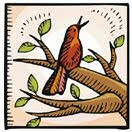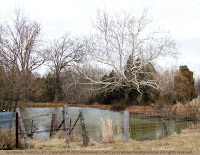Juniperus virginiana, eastern redcedar
 This is the bark of the eastern red-cedar (juniperus virginiana, photo at left.) The indigo bunting, a vividly blue bird that I love to see, uses strands of cedar bark in its nest. The gray catbird also weaves cedar bark into its nest. I wonder if the bark has enough cedar aroma to help control mites?
This is the bark of the eastern red-cedar (juniperus virginiana, photo at left.) The indigo bunting, a vividly blue bird that I love to see, uses strands of cedar bark in its nest. The gray catbird also weaves cedar bark into its nest. I wonder if the bark has enough cedar aroma to help control mites?The eastern red-cedar is a native of every state east of the Rocky Mountains. (See this range map.) Wherever it grows, it's a very important tree for birds.
The cedar waxwing eats so many cedar berries that it's named after the tree. Many other songbirds consume cedar berries regularly during the long months of winter -- bluebirds, mocking birds, grosbeaks, purple finches, and mockingbirds just to name a few from a long list. The fruit is also eaten by gamebirds -- wild turkeys, quail and pigeons.
In spring, the redcedar is sought out by various birds as a nesting spot because of the dense cover it provides. I have discovered several mockingbird nests in the cedar trees on our small rural property, and robins, song sparrows and chipping sparrows are also known to nest in cedars.
In winter, redcedars provide a sheltered roosting place for many songbirds, including juncos, various sparrows and myrtle warblers.
Tonight I walked down to the mailbox at sunset, accompanied by our two cats. I was amused when we passed a red-cedar growing at the edge of the neighbor's pasture. It was full of little birds. I knew that by the chorus of breathy little chirps they were making to each other. I think they were sending up a warning about the cats. If they hadn't been speaking, I would never have suspected that cedar tree was so full of birds!
The red-cedar is really a juniper; it's not a cedar at all. Scientists write its common name as "redcedar", but if I spelled it that way, most people would never find this page with a search engine. That's why I've written its name sometimes as "red-cedar" and sometimes as "redcedar."
----------
Related posts:
A few champion Eastern redcedar trees
Eastern redcedar: Pioneer species
Attracting bluebirds
Large Eastern red cedar tree at Fort Donelson, TN







.jpg)

























